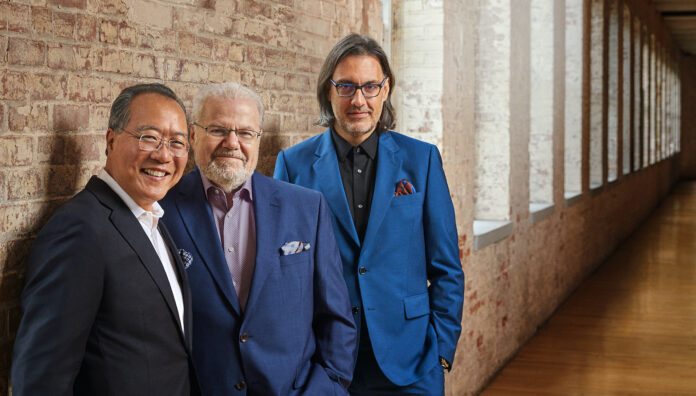How often is “sublime” the word that comes to mind when listening to three guys over the age of 50 play roughly 200-year-old music composed by a white German man with a shaky relationship with his major patron? A tempestuous composer who, at the time of writing said music, had begun to lose his ability to hear and was likely in a foul mood? What about when all these factors are at play while one is sitting with 2,000 people who, although masked, might carry one of a number of deadly viruses or (as did happen) with one forgetful person whose unmuted phone and a ringtone from hell breaks the spell not once, but three times, issuing 10-second intervals of dissonance that feel like 60?
When the “three guys” are a power trio including cellist Yo-Yo Ma, pianist Emmanuel Ax, and violinist Leonidas Kavakos; and when the music is Beethoven’s Symphony No. 4 in B-flat major, arranged for trio by Shai Wosner, and “Archduke,” Beethoven’s piano trio in B-flat major—the answer as to how frequently sublime sensation predominates is “always.” (Despite possible risk to personal health or audio abominations due to mobile devices.)
Serene sound was certainly in evidence on January 25, as the all-star trio appeared at Zellerbach Hall on the UC Berkeley campus. Presented by Cal Performances, the performance continued a collaboration Ma and Ax have pursued since 2014, when they played a program of works by Brahms at Tanglewood. The relatively recent addition of Kavakos that can be well-appreciated on brilliant recent release, Beethoven for Three, a recording of Beethoven’s Symphonies Nos. 2 and 5. It’s not just that the Greek violinist extends the small ensemble’s colors and expressive range while expanding the repertoire suitable for adaptation to trio. Kavakos—with his high energy and vigorous attack in some passages, sweet subtlety in others—appears to have ignited a similar flame in his revered fellow musicians.
From the first droning and weighted notes of Beethoven’s 4th Symphony, the masterful strokes position Ax’s piano as the night’s anchor; the parent to violin and cello “kids” who sparkle and romp and finally, illuminate shadows, if only we will wait for that moment to appear. And appear it did, after hints and suggestions that left a listener in suspense, when Kavakos’ violin broke loose and the trio raced to complete the first movement. This flip between tempos and tone quality was a tantalizing aspect of the work. The performance offered dazzling brightness in rapid passages—the bowing itself was cause for applause—and alternated virtuosity with jaunty, friendly, back-and-forth exchanges of simple musical motifs. Beethoven never overstays in either tone. Ever so nimble, the work frequently overlapped or stitched together with minimal transition the fluidity and luster of the violin and piano, with a river of ominous depth and darkness most often expressed by Ma’s cello.

Prior to performing the adaption, Ax explained that presenting a symphonic work as a trio, minus the timpani, brass, and woodwind instrumentation of a 100-piece orchestra, is actually a return to authentic form. In 1806, when Beethoven wrote this and other symphonies, orchestras were few and far between. That meant the public was unlikely to hear a large piece by Beethoven performed unless it was presented by a trio or small ensemble or, in larger cities, it happened to be on the repertoire of the resident orchestra. In 2023, the miracle of seeing live bodies after nearly three years with few in-person performances was enhanced by the awareness that these three remarkably gifted musicians, let alone anyone in the audience, might easily never have survived to deliver or receive this splendid music. The grounding of the experience in 200-year history felt simultaneously humbling, enormous, grand, cyclical, and human.
Similar terms could apply to the work that followed intermission, the “Archduke” trio written in 1811 and first performed in 1814. Program notes described Beethoven’s insistence on playing the piano at the work’s premiere, despite his profound hearing loss: “The result was uncomfortable for the audience. The diarist Louis Spohr attended the concert and recorded that ‘on account of his deafness there was scarcely anything left of the virtuosity of the artist which had formerly been so greatly admired … the music was unintelligible. I was deeply saddened at so harsh a fate.’ A repeat performance of the trio was Beethoven’s last public appearance as a pianist.” Subsequent performances by other musicians established the strength of a composition that is now recognized as one of Beethoven’s finest chamber works.
The trio found balance between the piano’s capacity to render a cascade of notes and guarded against the possibility of the keyboard dominating the sound by thinning the passages played by left and right hands. Occasionally, the piano thrust forward the most melodic, memorable themes with the violin or cello. At times setting aside their bows and plucking the strings, Ma and Kavakos lent a lighthearted, rhythmic texture to the scherzo. The chorale-like third movement “Andante Cantabile” was arguably a pinnacle moment, casting an elegant, dignified glow to every corner of the concert hall. A return to jubilance and buoyancy in the final section had the trio leaping through multiple key signatures and showcased the impeccable hands of Ax, whose reputation as a scholar was in no way undermined by the rock star turn on the keyboard.
When Ma, Ax, and Kavakos finished spinning their magical web with an encore of Beethoven’s “Allegretto ma non troppo” from Piano Trio in E-flat major, Op. 70, No. 2., the evening ended with one last glimmer of the sublime.
Help us save local journalism!
Every tax-deductible donation helps us grow to cover the issues that mean the most to our community. Become a 48 Hills Hero and support the only daily progressive news source in the Bay Area.





